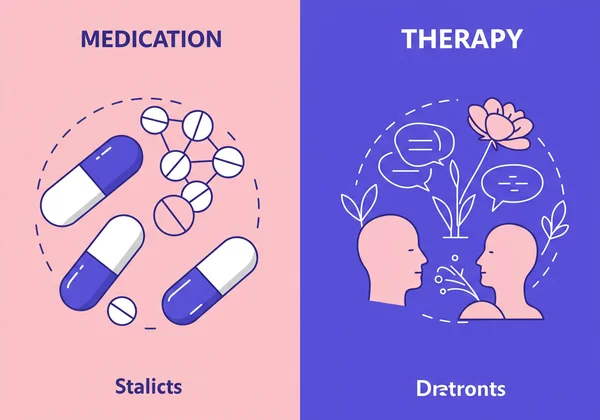Bipolar Disorder Test vs. Borderline Personality Disorder: Key Differences
Feeling confused by your mood swings? You're not alone. Many people wonder if their intense emotional experiences point to Bipolar Disorder or Borderline Personality Disorder (BPD). While both conditions involve significant mood instability, they are distinct, and understanding their features is crucial for finding the right path forward. This guide will clarify the key differences, helping you gain insight and navigate your way to an accurate understanding. If you're asking yourself, Am I bipolar or borderline?, you are taking a brave first step toward clarity.

The journey to understanding your mental health can feel overwhelming, but tools are available to help. A great starting point is to explore your symptoms in a structured way. An online bipolar disorder test can provide preliminary insights into your mood patterns, offering a confidential way to begin this process.
Understanding Bipolar Disorder: Symptoms & Cycles
Bipolar Disorder is primarily defined by its cyclical nature. It involves distinct, sustained periods of elevated and depressed moods that are a significant departure from a person's usual self. These are not fleeting feelings but profound shifts in mood, energy, and activity levels that can last for days, weeks, or even months. Understanding these cycles is key to recognizing the condition.
The Distinctive Mood Episodes: Mania, Hypomania, and Depression
The cornerstone of a bipolar experience is the mood episode. These are not quick changes but prolonged states that color every aspect of a person's life.
- Manic Episodes: This is the "high" of bipolar disorder. It's more than just feeling good; it's a period of abnormally elevated energy, irritable mood, and a decreased need for sleep. During a manic episode, a person might engage in impulsive, high-risk behaviors, feel grandiose, and have racing thoughts. This state often significantly impairs daily functioning and may require hospitalization.
- Hypomanic Episodes: Hypomania is a less severe form of mania. While there's a noticeable shift in energy and mood, it's not severe enough to cause major problems in work or social life, and it doesn't involve psychotic features. To an outsider, the person may just seem unusually productive or energetic.
- Depressive Episodes: This is the "low" phase, characterized by deep sadness, loss of interest in activities, fatigue, feelings of worthlessness, and changes in sleep or appetite. A bipolar depressive episode can be indistinguishable from major depressive disorder, which is why a careful history of any past "highs" is so important for an accurate diagnosis.
The Impact of Bipolar Cycles on Daily Life
These powerful cycles can create immense disruption. The shifts between mania and depression can strain relationships, impact job performance, and make long-term planning feel impossible. A person's sense of self can feel fragmented, as their personality and capabilities seem to change dramatically from one episode to the next. Using a bipolar symptoms test can help map these changes over time.

Exploring Borderline Personality Disorder: Symptoms & Patterns
While Bipolar Disorder is defined by episodes, Borderline Personality Disorder (BPD) is characterized by pervasive patterns of instability. This instability affects emotions, relationships, self-image, and behavior. Unlike the long cycles of bipolar, the shifts in BPD can be much more rapid, often occurring within a single day or even hour-to-hour.
Chronic Instability: Emotional Dysregulation & Impulsivity
The core of BPD is intense emotional dysregulation. This means a person experiences emotions very strongly and has difficulty returning to a stable baseline after being emotionally triggered. These reactions are often disproportionate to the event that caused them, particularly in the context of interpersonal relationships. This emotional volatility is often paired with impulsivity in areas like spending, substance use, or reckless behavior, which can serve as a way to cope with overwhelming feelings.
Identity, Relationships, and Self-Harm Behaviors in BPD
Beyond mood, BPD deeply affects a person's sense of self and their connections with others. Key signs include:
-
Unstable Self-Image: A person with BPD may have a persistently unstable sense of who they are, leading to frequent changes in goals, values, or career aspirations.
-
Fear of Abandonment: An intense fear of being left alone, real or imagined, can lead to frantic efforts to avoid it.
-
Volatile Relationships: Relationships are often intense and unstable, swinging between idealization ("You are perfect") and devaluation ("I hate you").
-
Self-Harming Behaviors: Recurrent suicidal gestures or self-harm are unfortunately common, often used as a desperate attempt to manage unbearable emotional pain.

Key Differences: Diagnosis, Treatment, and Underlying Causes
Distinguishing between these two conditions is vital because it dictates the most effective path for treatment and management. Getting it right is the first step toward stability and well-being. This is why a thorough bipolar disorder diagnosis test process with a professional is essential.
Diagnostic Criteria: DSM-5's Role in Differentiation
Clinicians use the Diagnostic and Statistical Manual of Mental Disorders (DSM-5) to diagnose mental health conditions. For Bipolar Disorder, the diagnosis hinges on identifying at least one manic or hypomanic episode. For BPD, the diagnosis is based on a pervasive pattern of instability across multiple areas of life, meeting at least five of nine specific criteria. The key difference lies in episode vs. pattern.
Treatment Approaches: Medication vs. Therapy Focus
Treatment strategies highlight the core differences. The primary treatment for Bipolar Disorder is medication, specifically mood stabilizers, which help control the episodes of mania and depression. Therapy is an essential supplement to help with coping skills and medication adherence.
In contrast, the primary, front-line treatment for BPD is specialized, long-term psychotherapy. Dialectical Behavior Therapy (DBT) was developed specifically to treat BPD and teaches skills in mindfulness, distress tolerance, and emotional regulation. While medication may be used in BPD, it is for targeting specific symptoms (like depression or anxiety) rather than the core disorder itself.

Navigating the Challenge of Misdiagnosis in Bipolar & BPD
The overlap in symptoms like mood instability, impulsivity, and depression makes misdiagnosis in Bipolar & BPD a significant challenge. Many people with Bipolar Disorder are initially misdiagnosed with depression, while those with BPD may be mistaken for having Bipolar II Disorder due to intense mood shifts. Clarity starts with self-awareness. Taking a confidential bipolar screening questionnaire can provide a structured summary of your experiences to share with a healthcare provider, greatly aiding the diagnostic process.
Moving Forward: Your Next Steps Towards Clarity and Support
Understanding the fundamental difference between the sustained mood episodes of Bipolar Disorder and the chronic emotional instability of Borderline Personality Disorder is the most important takeaway. While this guide offers clarity, it cannot replace a professional evaluation.
If what you've read resonates with your experience, your next step is to seek further information in a safe and structured way. Your journey to understanding begins with a single step. We encourage you to start your screening on our homepage. This fast, confidential self-screening test can offer valuable preliminary insights and empower you with the knowledge needed to have a more informed conversation with a healthcare professional.
Frequently Asked Questions About Bipolar and Borderline Personality Disorder
Am I bipolar or borderline, how can I tell?
Only a qualified mental health professional can provide an accurate diagnosis. However, a key difference to observe is the timeline of your mood shifts. Bipolar disorder typically involves mood episodes lasting for days or weeks, whereas BPD involves intense emotional shifts that can happen multiple times a day, often triggered by interpersonal events.
What is commonly mistaken for bipolar disorder?
Besides Borderline Personality Disorder, conditions often confused with bipolar disorder include Major Depressive Disorder (if hypomanic episodes go unnoticed), ADHD (due to overlapping impulsivity and distractibility), and certain anxiety disorders. An accurate diagnosis requires a comprehensive evaluation of your long-term mood patterns.
Is there a test for bipolar disorder that can help me understand?
Yes, while there is no single "yes or no" test, a well-designed screening tool can be incredibly helpful. Online screening tools, like the one we offer, are inspired by clinical questionnaires like the MDQ. They serve to help you identify potential signs and patterns that warrant a discussion with a doctor, not as a final diagnosis.
How do you get tested for bipolar disorder professionally?
A professional evaluation for bipolar disorder is a comprehensive process conducted by a psychiatrist or psychologist. It involves a detailed interview about your personal and family medical history, your specific symptoms, and the duration and severity of any mood episodes. There is no blood test; the diagnosis is made through this clinical assessment. Taking our bipolar disorder self test beforehand can help you organize your thoughts for this appointment.
Disclaimer: This article is for informational purposes only and is not a substitute for professional medical advice, diagnosis, or treatment. The screening tool is not a diagnostic test. Always seek the advice of your physician or another qualified health provider with any questions you may have regarding a medical condition.